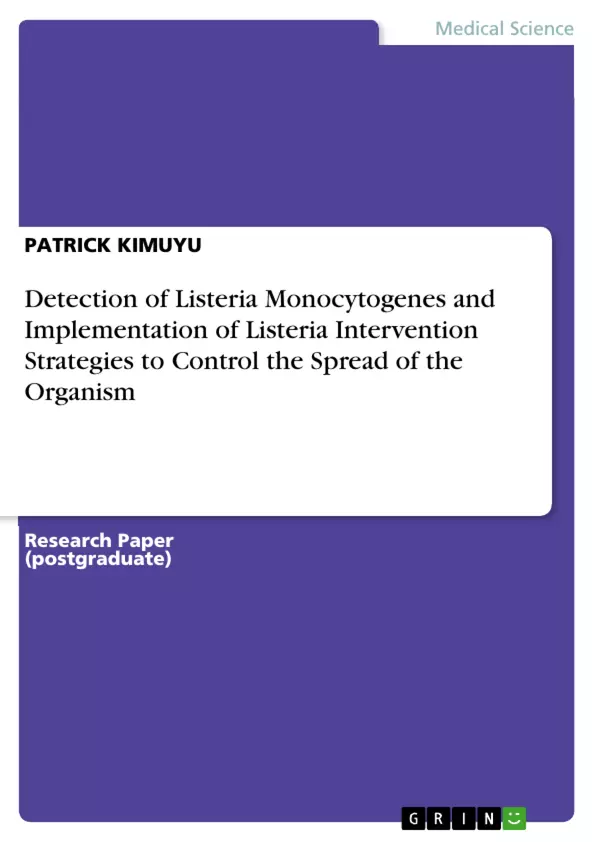Listeria monocytogenes remains to be one of the most leading causes of food-borne illnesses. It has become a serious problem in food manufacturing plants owing to its food poisoning capability which threatens the health of food products’ consumers, especially in the United States where food processing occur at a high magnitude compared to other parts of the world. Stephan and Jemmi (2006) report “listeriosis ranks among the most frequent causes of death due to food-borne illness. L. monocytogenes infections are responsible for the highest hospitalization rates (91%) amongst known food-borne pathogens and have been linked to sporadic episodes and large outbreaks of human illness worldwide”. This is attributable to its high case fatality, and this is probably the principal reason as to why L. monocytogenes is regarded as one of the most significant food-associated pathogen. This Gram-positive bacterium causes human listeriosis and contamination with L. monocytogenes has been one of the principal microbiological causes of processed food recalls, primary in regard to seafood, poultry, meat and dairy products such as milk and cheese. Research report indicates that the increased pathogenicity of L. monocytogenes is enhanced by its adaptability to food-processing environments. For instance, this bacterium can thrive and multiply under refrigeration conditions. It has also been found to thrive in drains in food processing plants. Moreover, L. monocytogenes ability to form biofilms enhances its colonization, distribution and adaptation to a wide range of environmental conditions including adverse temperatures and PH ranges.
Therefore, this paper will discuss the detection and identification of L. monocytogenes, and present comprehensive implementation of Listeria intervention strategies to control contamination of food products with the food-borne pathogen.
Inhaltsverzeichnis (Table of Contents)
- Introduction
- Detection and Identification of L. monocytogenes
- Implementation of Listeria Intervention Strategies
Zielsetzung und Themenschwerpunkte (Objectives and Key Themes)
This paper examines the detection and identification of Listeria monocytogenes, a significant food-borne pathogen, and presents comprehensive implementation of Listeria intervention strategies to control contamination of food products. The paper aims to provide a comprehensive understanding of the methods used to detect and identify this pathogen and the strategies that can be employed to mitigate the risk of contamination in food manufacturing environments.
- Detection and identification methods for Listeria monocytogenes
- Importance of controlling the spread of L. monocytogenes in food manufacturing
- Strategies for preventing and mitigating Listeria contamination
- Challenges and considerations in implementing Listeria intervention strategies
- Comparison of traditional and rapid detection methods for L. monocytogenes
Zusammenfassung der Kapitel (Chapter Summaries)
- Introduction: This section highlights the importance of controlling the spread of L. monocytogenes due to its high case fatality rate and potential for foodborne illness outbreaks. It introduces the pathogen's adaptability to food processing environments and its ability to thrive under refrigeration conditions. The paper's focus on detection, identification, and intervention strategies for L. monocytogenes is established.
- Detection and Identification of L. monocytogenes: This chapter explores various diagnostic procedures for detecting and identifying L. monocytogenes. It discusses morphological features, culture methods, biochemical and phenotypic markers, and DNA-based diagnostic techniques. The chapter emphasizes the importance of enrichment cultures for isolating L. monocytogenes and highlights the use of selective plates for identification. Traditional and rapid diagnostic methods, including PCR-based methods and antibody-based test kits, are compared and contrasted. The significance of isolation of bacteria colonies in epidemiological studies is mentioned.
Schlüsselwörter (Keywords)
Listeria monocytogenes, foodborne illness, food safety, food processing, detection, identification, intervention strategies, contamination control, enrichment cultures, selective plates, rapid diagnostic methods, PCR, antibody-based test kits, biofilms, foodborne pathogen, virulence, pathogenicity, food manufacturing.
- Arbeit zitieren
- PATRICK KIMUYU (Autor:in), 2017, Detection of Listeria Monocytogenes and Implementation of Listeria Intervention Strategies to Control the Spread of the Organism, München, GRIN Verlag, https://www.hausarbeiten.de/document/381290


